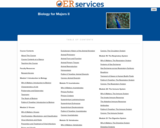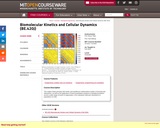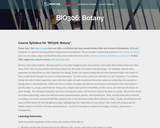
Module 1: Introduction to Biology
The Characteristics of Life
Prokaryotes and Eukaryotes
Taxonomy
The Study of Biology
Module 2: Chemistry of Life
Atoms and Elements
Atomic Bonds
Functional Groups
The pH Scale
Chemical Reactions
Thermodynamics
Assignment: Biological Astronaut
Module 3: Important Biological Macromolecules
Proteins
Lipids
Carbohydrates
Nucleic Acids
Comparing Biological Macromolecules
Assignment: Nutritionist for a Day
Module 4: Cellular Structure
Microscopy
Organelles
The Cytoskeleton
The Cell Surface
Assignment: Cell Builder
Module 5: Cell Membranes
Structure of the Membrane
Kinds of Transport
Endocytosis and Exocytosis
Assignment: Membranes Alive!
Module 6: Metabolic Pathways
Redox Reactions
Photosynthesis
Cellular Respiration
Fermentation
Assignment: Observing Energy Transactions
Module 7: Cell Communication
Signaling Molecules and Cellular Receptors
Propagation of the Signal
Response to the Signal
Signaling in Single-Celled Organisms
Module 8: Cell Division
Chromosomes and DNA Packaging
The Cell Cycle
Cell Cycle Checkpoints
Meiosis
Genetic Diversity
Errors in Chromosome Number
Assignment: Mitosis and Meiosis Internet Quests
Module 9: DNA Structure and Replication
Storing Genetic Information
DNA Base Pairs and Replication
DNA Mutations
Assignment: Which Has More DNA?
Module 10: DNA Transcription and Translation
Transcription
Translation
Prokaryotic Transcription and Translation
The Central Dogma
Module 11: Gene Expression
Regulation of Gene Expression
Prokaryotic Gene Regulation
Eukaryotic Gene Regulation
Assignment: How Mutations Work
Module 12: Trait Inheritance
The Father of Genetics
Beyond Dominance and Recessiveness
Heredity and Disease
Genetics and the Environment
Assignment: Dragon Genetics
Module 13: Theory of Evolution
Charles Darwin
Evidence for Evolution
Mutations and Evolution
Phylogenetic Trees
Module 14: Modern Biology
Key Technologies
Biotechnology Applications
Risks and Benefits of Genomic Science
Assignment: When Jabberjays Attack!
- Subject:
- Biology
- Natural Science
- Material Type:
- Full Course
- Author:
- Lumen Learning
- Date Added:
- 11/30/2020


















